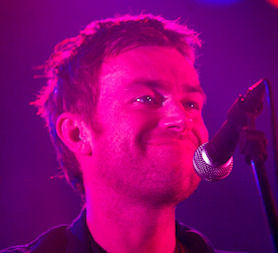Camera-snooped for a Blur documentary
Scooping Blur’s only TV interview as the band reunited last year was not as straightforward as it first appeared. Stephanie West recalls her reluctant appearance in a Blur documentary.

So often you have to persuade sensitive, reluctant souls to give interviews and let us film them doing their stuff. But recently, I got a sense of what it feels like to be filmed and then diced and spliced in some distant cutting room, when I and Channel 4 News cameraman Bruce Shayler ended up in a Blur documentary.
It began last year. Arriving to interview the band, it was with a sinking heart we saw the record company film crew hovering in the background. They asked to stay for our interview, to film us, filming the band. As we’re always asking for access, it seemed churlish to deny it to others, so we let them stay.
This was Blur’s only TV interview, as they started on a reunion concert trail that would culminate in headlining Glastonbury. They’d sold out every date, so didn’t need any promotion, and just wanted to get on with the job in hand. So we had to tread softly.
There was a nervous buzz in the tiny rehearsal rooms. They’d got back together after Damon Albarn and best friend Graham Coxon had patched up some differences, and seven years later the band were rediscovering their music and chemistry. It felt like we were crashing a very private affair.
There was a nervous buzz in the tiny rehearsal rooms.
When, many months later, I got an invitation to the premiere of No Distance Left To Run, the resulting documentary, I went, not really expecting our footage to have made the cut. But I was wrong.
After the lights went down one of the first shots after the opening montage was Bruce picking up his camera, as I pointed out “which one was Damon”. The audience laughed and laughed again as Damon was then introduced to Bruce.
“How long is this going to go on?” I thought, cringing as I was caught smoothing my hair and assuring Albarn that no, he didn’t have to be enthusiastic if he didn’t feel like it. The documentary then ran the top of our interview.
In fact, the audience was getting to see a real star at work. On the day, Bruce didn’t need to know the history of the band, he just instinctively melted into the background and expertly caught each little interchange and private moment.
We interviewed all four of them together, with just one camera. But with decades of experience, Bruce made it look easy, moving the shot effortlessly from musician to musician, his watchful eye unfailingly anticipating who was going to speak next. A delight to work with.
In fact, he was delighted to be included in the documentary. But not everyone was.
By coincidence I’d recently interviewed Blur’s tour photographer, Pennie Smith, on another story. Smith, who’s been in the business for decades, and famously captured Paul Simonon smashing his bass for the front cover of London Calling, was also caught on camera in the documentary.
She later emailed me, and we commiserated together in email cyberspace about how creepy it felt to be “camera-snooped” – even though you could argue that’s what our job entails most of the time.